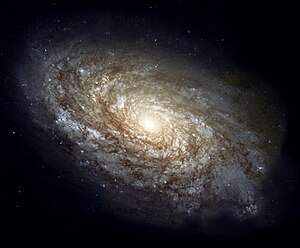Thousands of galaxies crowd into this Herschel image of the distant Universe. Each dot is an entire galaxy containing billions of stars. For more than a decade, astronomers have puzzled over strangely bright galaxies in the distant Universe. These ‘luminous infrared galaxies’ appear to be creating stars at such phenomenal rates that they defy conventional theories of galaxy formation.
The Hubble Space Telescope (HST) site estimates there are hundreds of billions of galaxies in the universe. A recent German super-computer simulation estimates that the number may be as high as 500 billion. A galaxy is a massive, gravitationally bound system that consists of stars and stellar remnants, an interstellar medium of gas dust, and an important but poorly understood component tentatively dubbed dark matter. Typical galaxies range from dwarfs with as few as ten million (107) stars, up to giants with a hundred trillion (1014) stars, all orbiting the galaxy's center of mass. Galaxies may contain many star systems, star clusters, and various interstellar clouds. The Sun is one of the stars in the Milky Way galaxy; the Solar System includes the Earth and all the other objects that orbit the Sun.

The Milky Way arches across this 360-degree panorama of the night sky above the Paranal platform, home of ESO’s Very Large Telescope. The image was made from 37 individual frames with a total exposure time of about 30 minutes, taken in the early morning hours. The Moon is just rising and the zodiacal light shines above it, while the Milky Way stretches across the sky opposite the observatory.
The stellar disk of the Milky Way Galaxy is approximately 100,000 light-years (30 kilo parsecs, 9×1017 km) in diameter, and is considered to be, on average, about 1,000 ly (0.3 kpc) thick. It is estimated to contain at least 200 billion stars and possibly up to 400 billion stars, the exact figure depending on the number of very low-mass, or dwarf stars, which are hard to detect, especially more than 300 ly (90 pc) from our sun, and so current estimates of the total number remain highly uncertain. This can be compared to the one trillion (1012) stars of the neighboring Andromeda Galaxy.
NGC 4414, a typical spiral galaxy in the constellation Coma Berenices, is about 55,000 light-years in diameter and approximately 60 million light-years away from Earth.

No comments:
Post a Comment